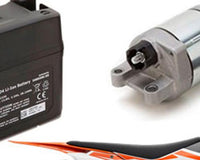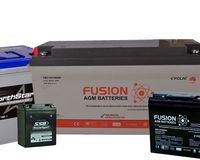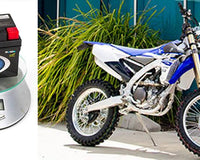Table of Contents
The main components of lithium batteries are the anode, cathode, electrolyte, and separator.
Lithium batteries also have a protection circuit to prevent overcharging and battery damage.
These components are behind the wireless-portable revolution that sums up today’s technology. They are the powerhouse behind our cell phones and cordless vacuums.
We’ll be looking at these modules and how they work together to power the world.
Inside the Anode Terminal
Early lithium batteries consisted of metal lithium at the anode (negative terminal). They relied on lithium’s light weight and high energy density.
These features were vital for making electronic devices portable without compromising functionality.
However, metal lithium cells developed unwanted dendrites on the anode during charge cycles. These dendrites would penetrate the terminal separator and short-circuit the battery.
Also, the cell’s temperature would rise to lithium’s melting point, causing thermal runaway.
Due to these drawbacks, research shifted to lithium-ion batteries, which used carbon graphite anodes rather than lithium metal anodes.
Graphite has a crystal structure of layered plains. They hold lithium atoms between each layer through intercalation.
The lithium molecules leave and reenter the graphite layer over several charge cycles without forming dendrites.
As such, graphite functions as a stable storage space for lithium atoms.
Inside the Cathode Terminal
Cathode materials consist of various metal oxides, usually categorised by voltage. This classification is because the cathode material used also determines the battery’s voltage.
In case of a high potential difference between the anode and cathode terminals used, a cell will have a high voltage. Alternatively, a lower potential difference between the terminals means a lower voltage rating.
The following table highlights the most common cathode materials by their voltage rating.
| Voltage | Cathode material |
| 2 Volts | Titanium disulfide, molybdenum disulfide |
| 3 Volts | Manganese dioxide, vanadium pentoxide |
| 4 Volts | Lithium cobalt oxide, lithium nickel oxide, lithium manganese dioxide |
| 5 Volts | Lithium manganese phosphate, lithium cobalt phosphate |
source: Energy Science and Engineering
The energy in a battery is proportional to the cell’s operation voltage. As such, a greater cathode voltage is desirable. However, a higher voltage affects electrolyte stability and must be carefully considered.
Lithium cobalt oxide and lithium iron phosphate are popular with commercial Li-ion batteries. This prevalence comes from their excellent service life of more than 500 charge cycles and stability.
Both metals have specific properties, which we look at below:
Advantages of Lithium Cobalt Oxide
- It’s easy to manufacture at scale
- It has a long service life of over 500 charge cycles
- It is stable in the air
Disadvantages of Lithium Cobalt Oxide
- It is less eco-friendly than lithium iron phosphate
- It has low practical (140 mAh/g) and theoretical capacity (274 mAh/g)
Advantages of Lithium Iron Phosphate
- It’s economical and has a lesser environmental impact than lithium cobalt oxide
- It has excellent temperature tolerance (-20°–70°C)
Disadvantages of Lithium Iron Phosphate
- Poor ionic and electronic conductivity (10^−10 cm 2/sec and 10^−8 cm 2/sec)
- It can easily be blocked by impurities and defects
Inside the Lithium Electrolyte
An electrolyte allows lithium ions to move between terminals while preventing electrons from doing so. This vital function necessitates that:
- The electrolyte can withstand the redox environment at both terminals and the voltage range involved without degrading
- The electrolyte can tolerate acceptable temperature ranges for charging and discharging
Commercial Li-ion electrolytes consist of lithium salts in organic solvents. Lithium salts facilitate ionic movement while the solvents promote electrolyte stability and the formation of a solid-electrolyte interphase (SEI).
The SEI forms at the anode during the first charging cycles to protect against further electrolyte decomposition.SEI formation is necessary for durability and is why modern Li-ion batteries have excellent charge cycles. Here’s an example:
This battery offers excellent cyclic properties with a long service life of 2,000 charge cycles. It represents the durability of modern Li-ion batteries.
When Skyrich Batteries designed the SSB PowerSport, they sought a lightweight cell with excellent service life. These criteria were necessary considering they build batteries for ATVs and motorcycles.
Accordingly, this battery offers more than ten years of service life with more than 2,000 charge cycles.
“Top battery and great service. Couldn’t be more happier, I received a quality battery, good friendly service at the best price.”
Richard — Verified Buyer
Inside the Terminal Separator
Separators function as a barrier between the anode and cathode terminals while enabling the exchange of lithium ions from either side.
On charge, the lithium ions move from the cathode to the anode and in reverse during discharge. The electrolyte moistens the separator to form a catalyst for this ionic movement. Although lithium ions are free to move across the separator, electrons are not since the separator has no electric conductivity. This property is how separators isolate the anode and cathode terminals from each other.
Although lithium ions are free to move across the separator, electrons are not since the separator has no electric conductivity. This property is how separators isolate the anode and cathode terminals from each other.
Commercial Li-ion batteries use polyolefin as a separator due to its excellent electrochemical stability at 4.2 V or higher and is economical.
Additionally, polyolefin has a uniform pore size which is optimal since Li-ion separators should have pore sizes ranging from 30–100 nano-meters.
Finding Your Lithium Battery
Now that you know what’s inside your lithium battery, are you ready for your next power project?
Maybe you’re looking for a reliable power source for that lighting project, or you’re after new batteries for your alarm and security system.
At HBPlus Battery Specialists, we provide services for all battery requirements. Our services include designing, manufacturing, and distributing a wide selection of batteries.
Contact us today to learn more about our services.
Frequently Asked Questions
What is the shelf life of Li-ion batteries?
Li-ion batteries last between 2–3 years, equating to 300–500 charge cycles.
What are the uses of Li-ion batteries?
Li-ion batteries have various applications, from consumer electronics to energy storage systems to electric vehicles.
Do Li-ion batteries work in the cold?
Li-ion batteries rely on chemical reactions to function. As a result, low temperatures can inhibit those reactions.
Do lithium batteries need ventilation?
Yes, they do.
Although lithium batteries don’t produce gases in the same way as lead-acid batteries, they need ventilation to prevent heat build-up and thermal runaway.









